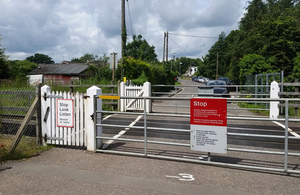Report 08/2017: Near miss at Dock Lane level crossing
RAIB has today released its report into a near miss between a train and a level crossing user at Dock Lane, Melton, Suffolk, on 14 June 2016.

Image showing Dock Lane user worked crossing
Summary
At about 13:25 hrs on Tuesday 14 June 2016, the passenger of a car that was waiting to cross the line was opening the gates at Dock Lane user worked crossing, in Melton, Suffolk, when a train passed over the crossing. The signaller at Saxmundham signal box had given permission for the car to cross the line after the car driver had contacted him using the telephone provided at the crossing.
The signaller knew the train’s approximate location before the call and was aware of its proximity to Dock Lane user worked crossing. However, during the call he did not use this information to decide to refuse permission to cross. Immediately after the call, the signaller realised the error.
It is possible that the signaller gave an automatic response to the car driver, partly because of the familiar nature of the telephone call and partly because of mental fatigue resulting from the complexity of maintaining awareness of train locations with the limited information that was available to him. Also, because he had been provided with all the information he needed to handle such a call without asking for it, he did not take the lead in the conversation. Had he done so, it might have reduced the chance of such an error.
The signaller at Saxmundham signal box is responsible for managing a high number of crossing telephone calls. The volume was such that it was highly likely that he would eventually make an error that could lead to a near miss or an accident.
Recommendations
The RAIB has made four recommendations to Network Rail, addressing management of human error when assessing level crossing risk, assessment of the signaller’s workload at Saxmundham, identification and assessment of other signalling locations with a high workload from level crossings, and the criteria for triggering assessment of workload demands on signallers.
Notes to editors
- The sole purpose of RAIB investigations is to prevent future accidents and incidents and improve railway safety. RAIB does not establish blame, liability or carry out prosecutions.
- RAIB operates, as far as possible, in an open and transparent manner. While our investigations are completely independent of the railway industry, we do maintain close liaison with railway companies and if we discover matters that may affect the safety of the railway, we make sure that information about them is circulated to the right people as soon as possible, and certainly long before publication of our final report.
- For media enquiries, please call 01932 440015.